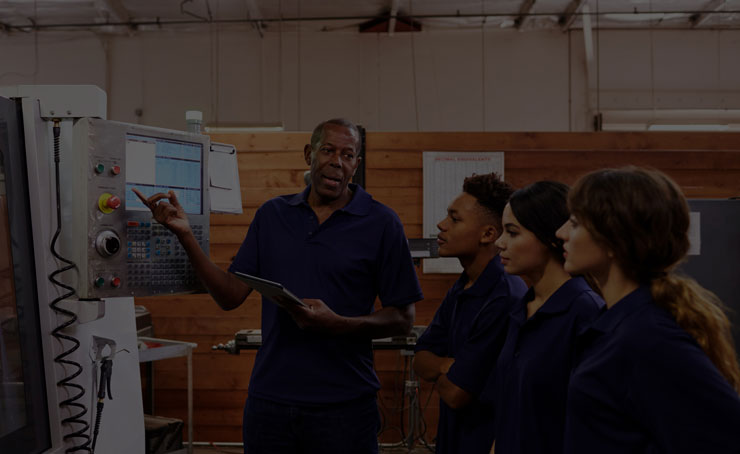Be a Blog Subscriber
Join thousands of manufacturing leaders and professionals who get the Accelerate blog delivered straight to their inbox


Back in 2011, we asked the industry a simple yet essential question: Is your workforce ready?
At that time, despite high general unemployment, a critical shortage of skilled workers threatened the future of manufacturing in America. Tooling U-SME — and other experts — predicted that if the skills gap was not immediately addressed, the crisis would dangerously accelerate in the next decade.
We knew that between rapidly changing industrial technology and the pending retirement of millions of baby boomers, the manufacturing industry was going to be hit by a serious depletion of skilled labor.
To reinforce the urgency, Tooling U-SME launched its Mission Critical: Workforce 2021 initiative, a forward-looking strategy to help manufacturers face and solve these workforce challenges.
To assess and gauge a company’s performance related to this challenge, Tooling U-SME introduced a Workforce 2021 Readiness Assessment tool. Hundreds of manufacturers completed the assessment which showed that three issues related to the skills gap need to be immediately addressed:
And here we are, a decade later. How did we do as an industry?
Unfortunately, the news is not good. We are in a crisis situation when it comes to workforce development, even worse than 10 years ago.
We were seeing some progress. Throughout the last decade, manufacturers have built momentum as they started creating and sustaining a strong pipeline of workers. Strategies having a positive impact include:
Then 2020 hit.
Few would have predicted that a pandemic would disrupt the entire world. The arrival of COVID-19 caused manufacturers to scramble to rethink their businesses and address major financial, staffing and operational challenges.
Manufacturers focused foremost on keeping employees safe while at the same time adjusting to remote work, reconfiguring facilities to accommodate social distancing, dealing with supply chain shortages and meeting customer needs.
The workforce was changed. The pandemic sealed the deal when it came time for retirement as many older employees did not want to risk infection by working onsite.
All industries, from foodservice to retail, lost employees. For some, remote education for children meant parents couldn’t work outside the home. Others didn’t want close contact with customers. Some employees found new jobs working from home.
Competition is fierce.
With salaries and incentives increasing across all industries, manufacturers are just one more option for candidates looking for new jobs.
Hard to believe, but the situation has become even more critical. Decisions made today will impact our industry many years into the future.
As the new year is upon us, I do want to leave you with some hope.
As it does best, the manufacturing industry is taking a fresh look at its current circumstances and asking, how can we adapt and innovate? Here are some examples.
The pandemic has helped the manufacturing community realize it is time to accelerate their move to smart manufacturing.
A decade ago, additive manufacturing, IIoT, robotics, cloud manufacturing, and data analytics were still unexplored in many manufacturing environments.
These last years of COVID-19 confirmed the essential role of advanced technology. For instance, some smart factories were able to monitor equipment remotely and assess/complete maintenance from afar using digital tools such as augmented and virtual reality. Collaborative robots (cobots) were introduced to address social distancing challenges.
This fall, SME and CESMII – The Smart Manufacturing Institute, announced a partnership to drive smart manufacturing further and faster by aligning their resources and educating the industry, helping companies boost productivity, build a strong talent pipeline, and reduce manufacturers’ carbon footprint.
As Robert Willig, CEO, SME, said, “Together, CESMII and SME will optimize our strengths and resources to accelerate the transformation and democratization of the smart manufacturing ecosystem and jumpstart productivity.”
One of the first initiatives of the new partnership is focused on manufacturing workforce education. The program will leverage the extensive reach into industry and academia that we have at Tooling U-SME. In addition, the combined training portfolios of both organizations and new content collaborations will expedite smart manufacturing adoption, driving progress through transformational workforce development. We are excited to work with manufacturers on this new initiative.
With fewer employees doing more along with the need to bring new hires quickly up to speed, training is more important than ever.
Innovation is also transforming training delivery.
At Tooling U-SME, we have seen increased demand for our elearning classes on topics from additive manufacturing and cybersecurity to data collection and machine learning. Employees appreciate the ability to learn when and where they want. It’s also seamless for employers to track completion of courses for internal development programs or as required by regulatory bodies.
We are also tapping into the popular gaming mentality of younger workers with the introduction of virtual reality (VR) labs which provide an efficient way to safely build skills after trainees complete their online curriculum and before training on real equipment.
As we have discussed, finding employees is a top priority. Again, the industry is innovating and looking at new ways to recruit.
We are inspired by many of our partners who are building awareness of career opportunities in the manufacturing industry and creating training programs for underserved communities.
For instance, offered through the Robert C. Byrd Institute, West Virginia’s Manufacturing Technology Center (RCBI), Apprenticeship Works initiative, the Step up for Women Advanced Manufacturing Pre-apprenticeship program is designed to help women in the region earn family-sustaining wages. The program is offered in partnership with another organization, West Virginia Women Work.
Jane Addams Resource Corporation (JARC) is another organization doing important work, teaching low-income adults and workers skills to earn a family-sustaining wage. JARC provides free training in welding, CNC operation, press brake operation, and mechanical assembly at three training facilities in Chicago. The self-paced training programs provide trainees the opportunity to grow at their own speed as they work toward industry credentials including AWS, NIMS, and Tooling U-SME’s CMfgA certification.
Another successful program is The Eastern Connecticut Manufacturing Pipeline Initiative (MPI) which was developed in 2016 to address the urgent need for skilled trades workers at General Dynamics Electric Boat, the Groton, Conn.-based submarine designer and builder, and nearly 50 companies in the Eastern Advanced Manufacturing Alliance (EAMA). Built on specific employer needs, the relatively short six-to-eight-week free training programs are designed to accommodate unemployed and underemployed workers who are unable to attend longer-term training.
These are just a few of the effective programs focused on building a skilled and highly trained workforce to continue moving manufacturing companies and our country forward.
By working together, all of us can ensure the manufacturing industry solves these pressing problems — and make the manufacturing industry better and stronger than ever in the next decade.
Wishing you all the best during the holidays and into the New Year!
Join thousands of manufacturing leaders and professionals who get the Accelerate blog delivered straight to their inbox